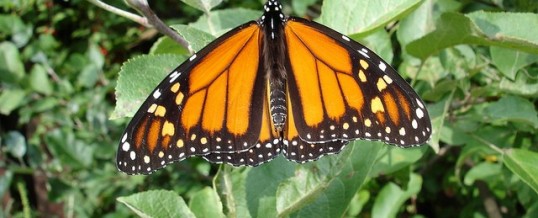
Old Man Winter is finally starting to release the hold he has had on my little part of the world for the last few months. Yesterday while waiting for the bus with my daughter we were serenaded by little birds gathered in the top of one of the trees. This past weekend our backyard was alive with grey squirrels, the first time I have seen them around in ages. And just this morning I saw a chipmunk, the first one I have seen since fall, scoot across the snow. Yes, spring is on the horizon, and while I’m guessing Old Man Winter still has a few tricks up his sleeve, my thoughts are turning to flowers and all the beautiful things that come with spring and summer.
Along with flowers, green grass, and warmer days, I hope the coming months bring the return of many monarch butterflies. There was a time when I wouldn’t have given this a second thought. For as long as I can remember the arrival of spring and summer here has also meant the arrival of beautiful monarch butterflies. As a child I would chase after them, hoping to catch one and hold it in my hands. Of course I was never successful, just as I would reach for one it would fly away. Now I love to watch the beautiful creatures dart around my yard, landing on flowers and shrubs, as my children try to catch them.
Sadly the monarch butterfly is in danger. In the past two decades the monarch population has declined by 90%, from an estimated one billion in the mid 1990’s to approximately 56.5 million this past winter. Due to this alarming decline in the monarch population, the U.S. Fish and Wildlife Service is currently considering whether Endangered Species Act protection is warranted for the butterfly. While this status will not be decided for several months (a decision is expected in December), the Fish and Wildlife Service did announce last month that it would provide $3.2 million to fund monarch conservation projects.
While there are numerous reasons being cited for the dramatic decline in the monarch population: global climate change, drought and heat waves, urban sprawl, and logging on the Mexican wintering grounds, one of the biggest reasons is thought to be the increase in genetically engineered crops in the Midwest. It is in the Midwest, along the monarch’s migratory path, where the butterflies depend on milkweed for food and for a place to lay their eggs. Sadly the increased use of herbicides and genetically engineered Roundup Ready crops in this part of the country has wiped out much of the milkweed plants formerly located in corn and soybean fields. One estimate puts the loss of habitat in this part of the country at 165 million acres, an area roughly the size of Texas. Monarchs are not the only insect whose numbers are dwindling. Since 1947 the number of managed colonies of honey bees has dropped by more than four million beehives. Noted monarch scientist and ecologist Lincoln Brower with Sweet Briar College in Virginia said, “My feeling is if the monarch goes, it is like the canary in the coalmine.”
So what can be done to save the monarch? The first step is restoring the butterfly’s habitat. This can be done through a combination of controlling the use of herbicides and less frequent mowing of public roadsides where milkweed grows, according to Brower. There is also an initiative underway to plant milkweed along the monarch’s migratory route. The money granted by the Fish and Wildlife Service last month is a good start, but falls far short of the money which will be needed to restore enough of the monarch’s habitat to guarantee the butterfly’s future. For me, this is yet another reason to avoid genetically engineered food whenever possible. Given the prevalence of GMO’s in many different foods and the lack of labeling, this isn’t always easy. One easy way to avoid GMO’s is to use the search feature at greenestbeans.com. With just a few clicks you can find food that has been certified organic or has been verified as non-GMO and carries the seal of the Non-GMO Project. The butterflies thank you.
ShareMAR

About the Author: